All Stops to Puerto Princesa
Author: Shirlz
April, 2023
Once again my visa was running out and rather than another quick trip by air to Manila, I decided to take my chances with the weather and sail to Puerto Princesa, the nearest Philippines port of entry. It was still the transition period between the NE and SW monsoons with variable winds, although predominantly from the wrong direction to give me a comfortable sail from Kudat to Palawan. The distance was just a bit more than 200 nm to the NE. It was going to be a slow trip, but there are many places to anchor along the way with easy day-sailing distances between.
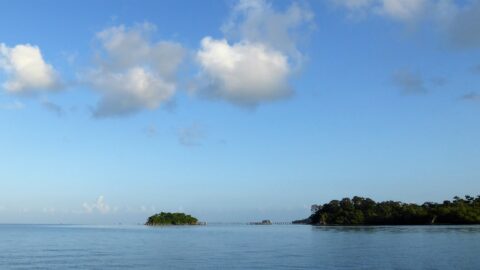
I waited in Kudat for a usable breeze to sail to my first stop at a well-protected inlet on the north coast of Sabah called (I think) Malubang. I was able to work my way quite far in, well past the small village and anchored in 4m on sand. The wind had picked up quite strongly from the NE and it was a good place to be. One or two small local boats passed and waved as they motored further up into the mangroves. Internet access was excellent and I was content to wait there as long as necessary.
To make good use of the time, I hauled out my sewing machine and put together a courtesy flag for the Philippines.
After a few days, the wind dropped sufficiently to make the next hop to Banggi. There was no need for the engine for the first half of the trip, but then I got caught up in some really scary current trying to use a shortcut through a reefy area. I had to back off and go the long way round the marker at the end of the reef. The afternoon wind picked up and it was a hard motor-sail for the rest of the way.
The anchorage at Karakit is not great and I was tempted to head straight on to Mitford Sound where there is good shelter, but it was getting late and I was getting tired. I anchored in 12m in a spot that I’d used before. Not very comfortable, but safe. I made an early start the next day and motored the 5nm to my anchorage at Mitford Harbour. The wind was still quite strong, but at least here the water was flat and it was a good place to be.
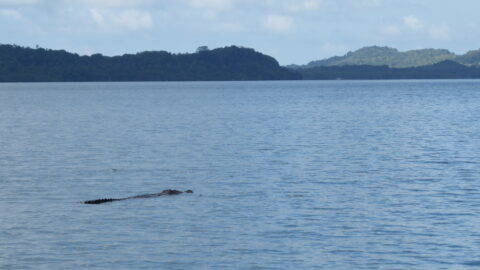
A few days later the wind had dropped again and I found out that it would be possible to buy some diesel at the dock ashore. It was a fairly long row to get there and while I was thinking about getting ready to go, and gazing out over the water, I spotted a rather big and lumpy log a little way off the boat. Got the binoculars out and to my horror realized it was an enormous crocodile. Just hanging there with one nasty, patient and speculative eye aimed at my floating home. It was definitely bigger and faster than my tiny dinghy. No long row ashore for me today!
After speaking to a local man the next day, I found out that the croc was a long-time resident in the area. Caution was advised. I really wanted that extra diesel, so I re-anchored as close to the mudbanks as I dared and rowed the short distance as fast as I was able. I soon found the diesel-man and had 20 litres siphoned into my jerry cans. The way the wind had been blowing it looked as though I was going to need it.
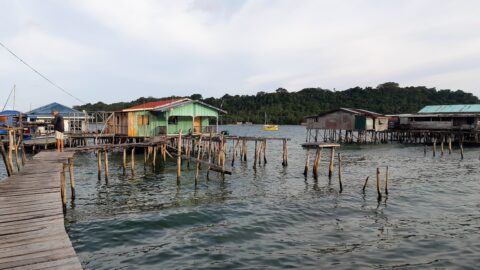
Gary had arrived from Kudat and I followed him through an alternative, interesting route through the mangroves to Karakit. The anchorage there was pretty rough and he gave me a lift ashore in his slightly bigger dinghy with outboard. We tied the dinghy to a rickety wooden ladder at the water village and walked along the wooden bridges between the houses to get to the main town. It was all quite amazing and rather wonderful. A low-budget Venice.
I bought some fresh stuff at the wooden ferry-dock market and the next day left early before the wind started. It was a pleasant little sail up the west coast of Banggi to a small bay which doesn’t seem to have a name, but was a great place to stop. Rather to my relief, a really heavy tropical downpour refilled my water tanks on day two.
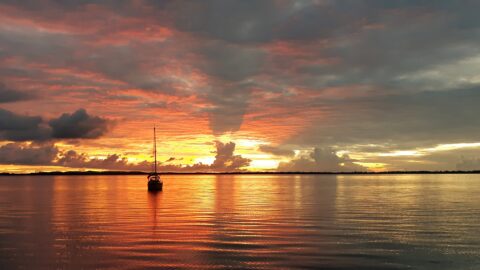
After a few days there, Balambangan Island was just a short sail across and I met up with Gary again who was helping his friend repair a dinghy. I joined him for a last G&T that evening, the weather was looking good for my attempt at crossing the Balabac Strait. A distance of about 35nm to the next anchorage at Clarendon Bay on the southern tip of Balabac Island.
The trip was uneventful but I was forced to motor-sail in order to get in before dark. When I arrived at the entrance to the bay I had to pick my way carefully through hundreds (thousands?) of plastic bottle floats marking the lines of seaweed farms. I eased my way in as slowly as I could, hoping that one of the men tending the weed might come over to guide me through. No one did and I miraculously managed to make my way to a clear patch at the far end of the bay where one of them gave me the thumbs-up to anchor. I later discovered that seaweed farming is an important source of income for the local people.
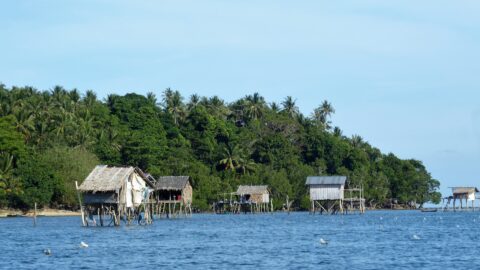
I spent the next day relaxing and watching the workers tending the seaweed. They would harvest enormous bales of the stuff and load it onto their tiny canoes to be paddled to the drying racks at their houses. Their small boats barely afloat under the heavy load. I kept a sharp eye out for crocodiles as Balabac is notorious for them. Hot as it was, I had no inclination to go for a swim.
Early next morning I retraced my route through the seaweed maze, grateful for the track that had been recorded on the Garmin GPS. Once out of the bay I was able to sail for a few hours but again had to resort to the engine to get in to the anchorage at Balabac Town before dark. This is the real problem with the day-sailing plan. Sailing close to the coast at night is a bad idea with many unlit fish traps and small boats and many of the anchorages need good light to be able to spot the hazards on the way in. Charts are unreliable, so it’s best to get in before dark. The little old engine is earning it’s keep.
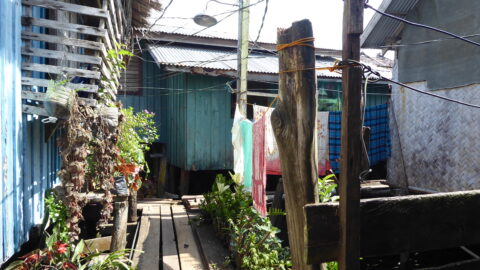
Balabac Town was a delight. An interesting wooden jetty to tie the dinghy to and clamber up a dodgy ladder, then a narrow passage through the stilt houses to the shore. Lots of small shops selling all the essentials and a fair selection of fresh fruit and vegetables. I was able to buy a new prepaid ‘plan’ for the sim card I had bought while in Manila and it was comforting to have internet access and be able to get a weather report again.
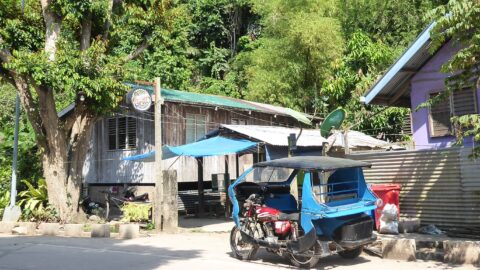
A good road winds its way along the coast between the stilt houses and the jungle and I went for a long walk to get some much needed exercise. There were a lot of weird-looking motor tricycles which reminded me of fast-moving extraterrestrial giant insects. I was fascinated by them and soon found out that they are a very convenient and cheap form of public transport.
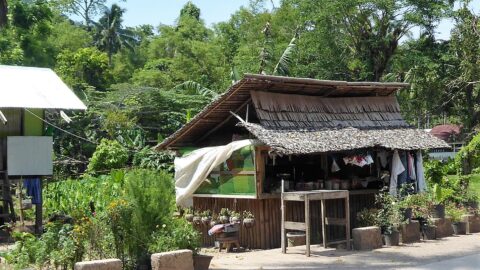
Unfortunately the weather forecast was not encouraging. Virtually flat calm for the next four days. I draw the line at wantonly pressing on without any hope of sailing, not to mention the fact that I don’t carry enough diesel to even think about it, so it looked as though we would be staying put for a few days.
One morning a smart Coast Guard boat came alongside and wanted to check my papers. I showed them my passport and exit papers from Kudat and they were happy. All very friendly and assured me it was no problem to wait for better weather.

When a gentle breeze at last arrived from a generally SW direction, I set sail at dawn hoping to reach the next anchorage at Iglesias Pt about 35nm away. We were moving quite nicely until the unfortunate moment when the tide turned and we stopped making any forward progress at all. Even with the engine, Iglesias was no longer going to be possible. I had been rather intrigued by the name of the nearest big island along the track: ‘Bugsuk’ did not have a welcoming ring to it. But it was only about 15 miles away and might be an option. I checked my charts and realized that it would be better to try anchoring between Canabungan and Mantangule Islands which were a little closer and offered fair protection. So we turned in there, and with the help of the satellite images that I had downloaded and the wonderfully clear water found our way in to a reasonable anchorage for the night.
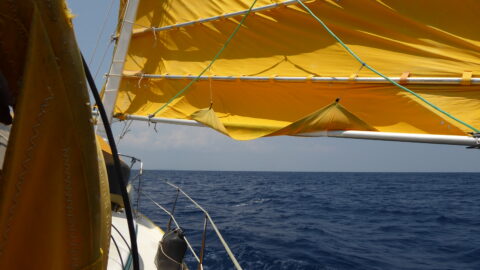
Another really early start just before sunrise and we were on our way to Iglesias Pt. At about 1100 the wind filled in from the west and we were able to sail the rest of the day. How wonderful to turn off the noisy engine and enjoy my amazing yellow sail. A big flock of white terns were busily diving on a shoal of small sparkling fish. We arrived at the anchorage at 1600 and had to pass two enormous barges also anchored in the bay. A third one arrived soon after we settled in at a respectful distance from another area of seaweed farms.
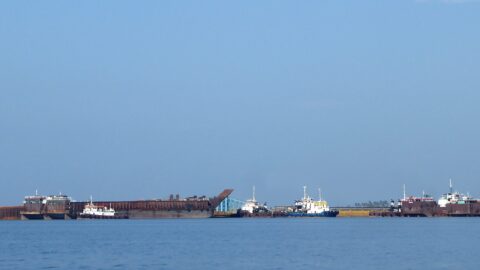
A day of rest and then on again. The wind followed the usual pattern which was flat calm in the morning then a light sea breeze in the afternoon. I was able to sail some of the way to Brookes Pt and anchored in 4m within easy rowing distance of the beach. The harbour was fairly busy with big ships coming in alongside the concrete dock and fishing boats scattered about.
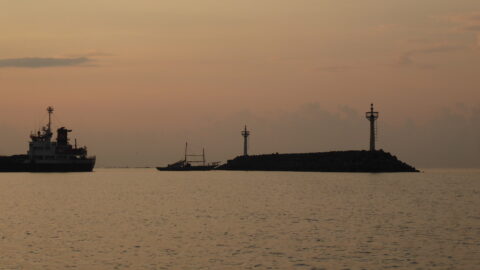
It was quite a long walk to the shops and market and we were having some very hot and windless days. I always carry a small folding umbrella in case of tropical showers, now it came in handy as a very effective sunshade. I explored the town and took a stroll down to the lighthouse. This side of the concrete jetty was filled with small outrigger boats as the water is very shallow and they draw virtually nothing. People were friendly and wanted to know where I was from. I was invited to sit and rest for a while under the shade of a stilt house, they were grilling some small fish on a grid over a pit of coals. I left them to enjoy their lunch and wandered on. Near my turn-off to the beach I found a small shop where I could pick up an icy cold ‘San Mig’ to take back to the boat.
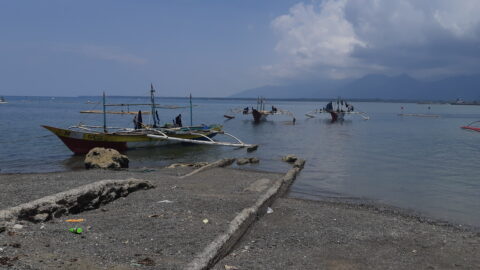
I badly needed more diesel and one morning, took my two 10 litre jerry cans ashore and got a ride on a tricycle to a big filling station in town. The driver helped with the cans and waited while they were filled, then took me back to the beach – practically right to the dingy! Wonderfully helpful.
After 5 days of no wind the forecast showed a promising easterly breeze and I set off at dawn heading for the anchorage at Crawford Cove about 30nm further up the coast. A few hours of nice sailing, but as usual the engine had to be resorted to so that we could maintain the necessary 3knot average and get in before dark.
There were quite a lot of fish trap stakes along the sides of the cove and what looked like a small settlement of sea gypsies on the shore. I anchored in the middle of the bay in 4.5 m. Next morning when I left a boatload of friendly waving people passed me, also heading out.
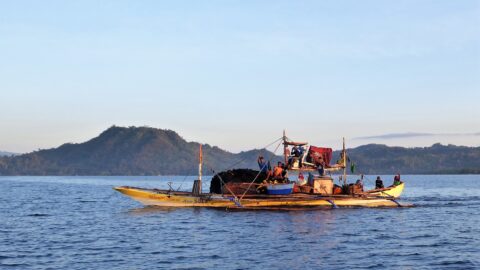
It was less than 20nm to the next anchorage at Rasa Island and we arrived before 3pm, again motoring to start in the early morning calm and then some pleasant sailing later. There was a forest of bamboo posts marking fishing nets along the sand-spit that extends from the mainland towards Rasa Island. Also some unmarked sandbanks in the bay. I carefully found a place to anchor off the beach. I’m starting to get used to being the only cruising boat in any of the anchorages where I’ve stopped. What a change from the Caribbean. Where are the mooring fields and big white charter cats?
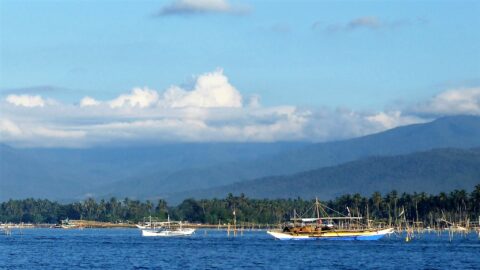
Next day Max and Glen, friends of Gary, came to pick me up at the beach and took me shopping in Narra where they are living. There was a very good fresh market and I was able to stock up again. Then lunch at their house and another diesel top up. Wonderfully helpful – Thank you!
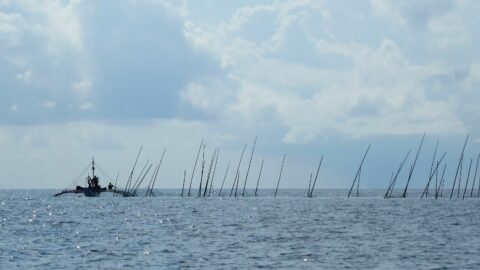
The wind was threatening to turn northerly again, so I set off once more at dawn and sailed the next 15nm to anchor in the shelter of Malanao Island. Another peaceful spot surrounded by mangroves with only occasional small-boat passing traffic. This will be my last stop before Puerto Princesa which is now less than 20nm away.












April 28th, 2023 at 12:56
Hi Shirley,
Good to see your latest blog. Did you get the news that a South African woman just won the round the world solo sailing and the first woman to win!! SA women are winners!
So enjoy your travels
Helena
May 1st, 2023 at 22:45
I enjoyed your latest post. In the past. I was disappointed your photos were so small. Today I simply enlarged the page and can see your photos so much better. I don’t know why I didn’t think of it earlier. If you get a chance. I would love to see another photo of the motor cycle tricycles from the other side. They look very interesting. Thanks again.
May 7th, 2023 at 20:01
Hi Shirley, another interesting post. Happy voyaging, Bob & Oli.